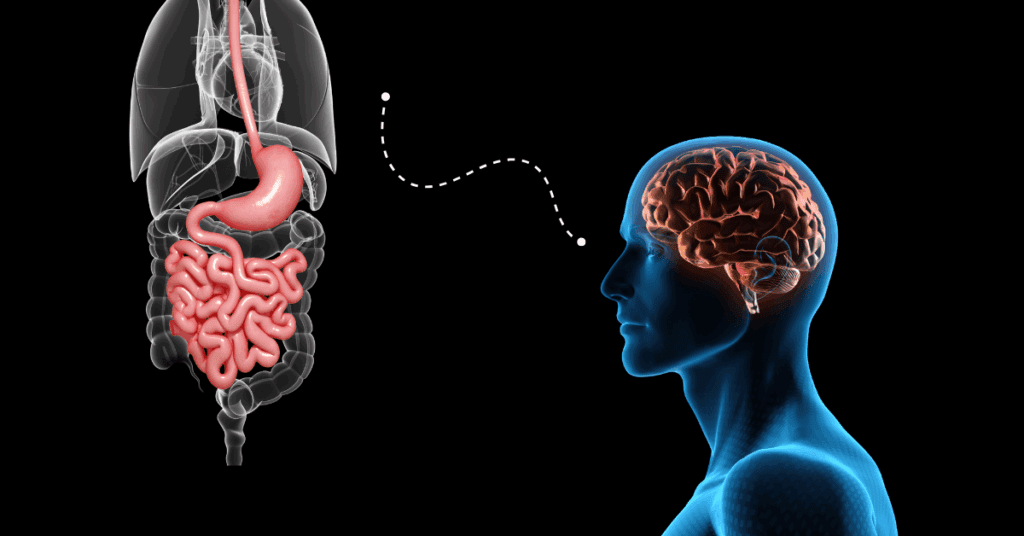Ever get a “gut feeling” or butterflies in your stomach before something stressful? That’s your gut-brain connection in action. Contemporary medicine acknowledges the close relationship between the brain and the gut. This relationship—referred to as the “gut-brain axis”—is the interaction of the digestive system, nervous system, hormones, and immune responses. Ayurveda and modern science both emphasise the strong link between digestion and the mind—this is the essence of Ayurveda and gut health.
Concepts like Agni (digestive fire), Doshas (energies), and Ojas (vital essence) form the foundation of Ayurveda and gut health. Ayurveda explains the concept by elaborating the link between Agni (digestive fire), Doshas (energies of the body), Dhatus (tissues), and Srotas (body channels). Let’s see how these two perspectives align and how combining them can improve gut and brain health. Let’s break it down in a way that’s easy to understand—and explain how Ayurveda sees it too.

What is the gut-brain axis?
So, what is the gut-brain axis? It’s the communication system linking the gut and brain through nerves, hormones, and immune responses.
1. Digestive Fire and Gut Microbiota - the gut and brain connection
The modern idea of microbiota balance is very close to Ayurveda’s Agni concept. This balance is central to the gut-brain connection. A healthy gut is filled with trillions of good microbes (microbiota) that break down food and secrete valuable substances like short-chain fatty acids (SCFAs)—for example, butyrate and acetate. SCFAs aid digestion, mood, and immunity. But when bad bacteria take over (called dysbiosis), you may feel bloated, foggy, or anxious.
This microbial balance is similar to robust Agni (digestive fire) and balanced Kapha (stability, nourishment). Disturbance of the microbiota (termed dysbiosis) is viewed in Ayurveda as Mandagni (dull digestion) and Ama (toxic accumulation). Each Doṣha controls aspects of gut function:
- Vata – movement (peristalsis)
- Pitta – metabolic activity
- Kapha – lubrication and stability
Disturbances in this result in poor digestion and toxin production, similar to current research of inflammation and dysbiosis. In simple terms, dysbiosis in modern science aligns with Ama buildup in Ayurveda and gut health principles.
2. Vagus Nerve and Enteric Nervous System
The vagus nerve links the brain and the gut and transmits messages in both directions. The vagus nerve is similar to a telephone line transmitting messages from your gut to your brain. It controls digestion, mood, and the immune system. The brain of the gut term is used for the enteric nervous system (ENS) because it possesses reflexes and controls the action of the gut.
Ayurveda: These correspond to:
- Prana Vata – supports vital functions like breathing and swallowing, like the vagus nerve.
- Samana Vata – governs digestion, nutrient movement, and gut motility, like the ENS.
- Majja Dhatu – tissue linked to the nervous system.
3. Systemic and Neuroinflammation
Ayurveda: This condition is interpreted as Pitta (heat and bile) aggravation in blood (Rakta), muscle (Maṃsa), and nerve tissue (Majja). Overheated blood “burns” through tissues and disturbs balance. Combined with poor Agni and Ama, it leads to Pitta-Vata imbalance.
4. Gut Barrier and Blood-Brain Barrier Integrity (Srotas and Ojas)
Your gut lining and the blood–brain barrier (BBB) protect you from harmful invaders. When they are damaged, harmful substances leak through, disturbing immunity and brain function.
Ayurveda: These are the Srotas (channels) carrying nutrients and life force. Their protection depends on Ojas (vital essence) and Kapha (nourishing fluids). Damage here is Srotodushti, or channel disturbance.
5. HPA Axis and Stress
Chronic stress results in HPA axis activation (hypothalamus–pituitary–adrenal) resulting in release of hormones such as cortisol, which compromise gut lining, disrupt gut bacteria, and harm the brain and induce inflammation.
Ayurveda: Stress raises Vata (dryness, restlessness) and Pitta (heat, agitation), upsetting Manovaha Srotas (mental channels). With time, it results in Majja Kṣaya (nerve tissue loss) and loss of Ojas.
Ayurveda Interventions for Gut–Brain Health
Ayurveda provides a natural treatment for neurological disorders through Panchakarma, Rasayana herbs like Ashwagandha, and diet regulation. To preserve gut–brain axis equilibrium, Ayurveda suggests:
- Enhance Digestion and Clear Toxins:
Take Trikatu (dry ginger, black pepper, long pepper) to enhance Agni (digestive fire) and other Ama-pachana (Carminative) herbs to remove toxins.
- Cleanse and Rejuvenate (Panchakarma):
- Virechana (purgation) to balance Pitta and inflammation
- Vasti (medicated enemas) to soothe Vata in the colon and nerves
- Nourish the Nervous System (Rasayana):
Herbs such as Ashwagandha, Brahmi, and Shankhapushpi nourish Majja Dhatu and enhance resilience
- Build Ojas and Kapha:
- Ghee, milk, rest, and mental calmness enhance Ojas, protect Srotas, and buffer the brain and gut.
Ayurveda for Neurological Disorders: A Gut-Centric View
Modern medicine recognises the microbiota–gut–brain axis as a two-way communication system between the gut and the brain, involving nerves (like the vagus), immune signals, hormones, and metabolic products. When this equilibrium is disrupted (a condition termed dysbiosis) or when the gut lining is “leaky,” it can lead to inflammation in the body and brain, leading to the development of neurological and psychiatric illnesses such as Stroke, Alzheimer’s, ADHD etc. While modern medicine looks at microbial imbalance, Ayurveda for neurological disorders identifies Vata imbalance and weak Agni as the root causes.
Key Neurological Conditions Linked to Gut Imbalance
- Alzheimer’s and Parkinson’s Disease:These illnesses tend to start with gastrointestinal symptoms such as constipation, years before brain symptoms occur. Research shows that people with early Parkinson’s have fewer beneficial bacteria (Faecalibacterium) and more harmful pro-inflammatory bacteria known as Collinsella. That imbalance not only leads to gut leakiness but also sets off their immune systems and allows toxic proteins like alpha-synuclein in Parkinson’s to build up. In Alzheimer’s, gut bacteria also influence protein accumulation in the brain (amyloid and tau). Interestingly, giving healthy gut bacteria to mice can improve memory and reduce brain damage.
- Anxiety and Depression:
We now know that mental health issues often coexist with or precede neurodegenerative diseases and have a connection to gut health. Research indicates that individuals with anxiety or depression have a different population of gut bacteria compared to those who are well. Animal research indicates that modification of gut microbes will produce depression- or anxiety-like behavior—and supplementation with certain probiotics such as Lactobacillus rhamnosus will reverse it. These actions are vagus nerve-dependent, a primary nerve that is responsible for the gut and brain connection. Gut bacteria also affect mood by producing serotonin, which is predominantly produced in the gut. In conditions of “leaky gut,” toxins are leaked into the bloodstream and cause brain inflammation, which exacerbates mood disorders. - Neurodevelopmental Disorders in Children:
Current studies indicate vast disturbance in the gut-brain axis in neurodevelopmental disorders, including autism spectrum disorder (ASD), ADHD, and cerebral palsy. ADHD research shows distinct gut microbiome alterations, including increased Bifidobacterium linked to enhanced dopamine precursor synthesis and altered reward processing.
Ayurveda identifies the gut-brain relationship through the concept of Agni (digestive fire) and its interaction with Manas (mind). The classical methods identify Vata dosha imbalance as the fundamental etiology of neurological disorders, with Pakwashaya (large intestine) as Vata’s principal location. Therapeutic interventions are Panchakarma detoxification, targeted herbal preparations, and Vasti (enemas). Both systems acknowledge bidirectional gut-brain communication, and Ayurveda’s Ojas concept is analogous to current understanding of health-promoting microbial metabolites that facilitate immunity and mental acuity. Current therapies involve probiotics, prebiotics, and fecal microbiota transplantation, whereas Ayurveda utilises herbal medicines to regulate gut microbiota populations and suppress neuroinflammation. This integrated knowledge recommends that treating the gut can provide comprehensive results for neurodevelopmental disorders.
Summary
| Modern Concept | Ayurveda Equivalent | Ayurveda Perspective |
|---|---|---|
| Microbiota balance | Agni, Dosha balance | Ayurveda for neurological disorders views gut disturbance as Mandagni and Ama formation |
| Vagus nerve, ENS | Prana/Samana Vata, Majja Dhatu | Neural communication, gut motility |
| LPS, cytokines, inflammation | Pitta aggravation, Ama | Tissue heat, toxin accumulation |
| Gut/brain barriers | Srotas, Ojas, Tarpaka Kapha | Channel integrity, protection |
| HPA stress, cortisol | Vata–Pitta aggravation, Majja Kshaya | Nervous depletion, Ojas loss |
By integrating modern medicine with natural treatment for neurological disorders from Ayurveda, patients can find holistic recovery. Ayurveda provides preventive and curative strategies that are still highly applicable today, such as balancing digestion, soothing the nervous system, and enhancing immunity.







